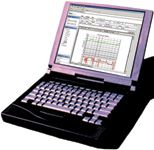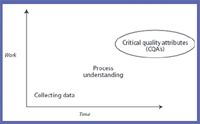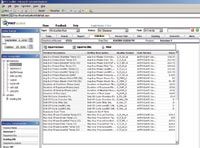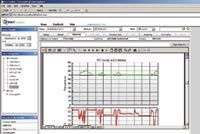The Five Steps to Starting PAT
Implementing process analytical technology principles can be a challenging task. This article presents a straightforward approach.
Some revolutions are violent and disruptive. Some revolutions are quiet and consistent. Process analytical technology (PAT) is certainly disruptive, but its adoption has been quiet and relegated to isolated pockets within the industry. As with any revolution, the skepticism abounds on whether this new way of doing things will stick. Simply put—is it worth the risk to change?

The pharmaceutical industry enjoys both the world's highest profit margins and intense FDA scrutiny. High margins blunt the economic incentives for continuous process improvement; heavy regulation stifles technical change. As a result, the pharmaceutical industry has fallen behind other automation communities.
And so, ironically, this science-based industry does not apply anything close to current science to its manufacturing side. Process analyzers have played a role in chemical manufacturing for more than 60 years. PAT offers the chance to help close this gap with our manufacturing counterparts.
This past fall, a KPMG analyst reported that 72% of drug recalls are a result of manufacturing defects. Public safety issues aside, manufacturing missteps on this scale impose a huge business drain—even before the costs of potential litigation.
To encourage progress, FDA initiated "Pharmaceutical CGMPs for the 21st Century: A Risk-Based Approach," which defined PAT as:
"Systems for analysis and control of manufacturing processes based on timely measurements, during processing, of critical quality parameters and performance attributes of raw and in-process materials and processes to assure acceptable end product quality at the completion of the process."
It is an exciting time to be involved in pharmaceutical manufacturing. At the same time, the proliferation of off-the-shelf PAT options makes it tough to know where to start. So, what is a PAT novice to do? Start small—very small. Tackling easily understood processes can make implementing PAT much more manageable.
Watching timely measurements show up live can be strangely satisfying. Whether you're plugging directly into a programmable logic controller (PLC) or dipping into a SCADA (supervisory control and data acquisition) system, seeing what happens in near-real-time is very powerful. This applies even if the process is already well understood. Building a knowledge foundation with PAT builds momentum and excitement for the next bigger and more complicated processes out there.
The trick is to begin with the right process. Here's how to get started:
- Pick simple.
- Understand all the details and nuances.
- Evaluate the instrumentation you already have, and the information you can easily collect.
- Understand the appropriate intervals for collecting that data.
- Evaluate the tools available for reading and synchronizing the data.
Pick simple
The options for PAT can be overwhelming: A number of technologies already can provide amazing information in real time. For example, near-infrared (NIR) spectrometry can provide almost instant quality assessment for identification of raw materials, provide an analysis of complex mixtures or process byproducts, or sniff out counterfeits. The technique is fast and can be configured to require little operator skill or sample preparation.
Integrating NIR into a production line is not a plug-and-play exercise, however. It demands time, resources, and knowledge. Still, NIR's robust reputation can tempt PAT novices into selecting it as a first PAT solution. Resist the temptation.
Let's step back for a second and consider other areas of pharmaceutical manufacturing. Take water, the foundation of any pharmaceutical manufacturing process. If a pharma company has periodic problems with its water-for-injection (WFI) system, it can foul up a number of subprocesses. Moreover, WFI production can carry high capital and operating costs. Finally, WFI production is usually well understood. A well understood, critical process with demonstrable influence on the bottom line: WFI can be the perfect jumping off point for PAT.
Understand the details
Assume that a team is ready to begin delving into PAT and needs to get budgetary approval to begin investigating. They have astutely picked a simple WFI process to show upper management where the money can be saved.
Now, this is where the real work of process analytical technology lies. A careful distinction must be made between tools that help provide a window into the process on the one hand and truly understanding the causes and effects of deviations on the other. Technology can help provide the former, but only hard work and scientific awareness can provide the latter.
For the WFI process, the PAT team might begin by investigating what values are acceptable for parameters such as flow rate and temperature. The team might, for example, investigate velocity characteristics of the water flow in order to understand which flow rates prevent or slow microbial growth. The PAT team can then begin developing worst- and best-case scenarios for production, developing a solid hypothesis against which to compare manufacturing.
Critical quality attributes (CQAs). This example hints at the importance of understanding the crucial parameters to achieving quality. CQAs are the underpinnings of PAT. Understanding what the absolute acceptable ranges for a given process are is paramount. From that foundation, the appropriate technology can be selected, installed, and used to bring real-time results and control (see Figure 1).

Figure 1: Relationship of critical quality attributes to time and work.
Too often, pharma companies start the process backwards. They install the analytical technology to measure the process before they completely understand what needs to be monitored. The end result is typically no change in controlling end-product variation and no better understanding of what is influencing the process. A lot of money can go down the drain for no gain, along with the possibility of doing bigger PAT projects.
Back to our WFI example: the entire PAT team could begin by correlating flow rates with bacterial growth, determining minimum velocities, and cross-referencing this data with industry standard guidelines. Next, the PAT team would gather a statistically significant data set from the production environment. These data can then be compared with the industry standards and expermimentally derived acceptable limits. The flow rate is now associated with CQAs to compare with what has happened in production. The next task for the WFI process team is to focus on the temperature readings and apply the same methodology.
How do you know when you have understood the process? These are the typical indicators:
- You can explain the variability from batch to batch.
- You can reliably predict whether a run will be good or bad from the in-process data.
- You have accounted for and understood all of the factors that can alter quality.
As mentioned previously, WFI is a good practice for first-time PAT because its success can often tie back to bottom-line results. Remember, the PAT team is usually under fairly intense scrutiny. If they can improve product quality and prevent rejects through something as simple as water, it can turn the political tide in their favor.
Another basic process to consider is building monitoring systems. Observing ambient temperatures may not be exciting, but it does give the PAT team invaluable experience on getting a system up and on-line. These are almost always stable processes, so variations can be explained and understood with modest investigative effort. Similarly, stand-alone equipment like autoclaves or glass washers can be rewarding for working with PAT on a micro scale (see Figure 2).

Figure 2: Screen shot of critical quality attributes for an autoclave.
Evaluate the data you already collected
At this point, a chicken and egg paradox emerges. Teams are starting to hypothesize about the parameters that influence end-product quality, but they don't want to invest in dynamic analytical technology until they have a firmer grasp of what to measure. But how do they measure the process to begin with? Unfortunately, there are no easy answers. Typically, process and automation engineers do the best they can with the available static measuring tools, in conjunction with the appropriate data-mining techniques, to get a picture of what has occurred within the process.
With the proliferation of SCADA systems at manufacturing sites, grabbing data is usually not a problem. Depending on the age of the plant, however, some stand-alone machines may not be writing their information to a central database. These situations can present a big roadblock to bringing the entire process up and running with PAT. Some currently available software solutions may be able to capture previously unrecorded data and synchronize it into the analyzing process.
How invasive must these tools be? The less invasive the better. Given the huge investment in an enterprise resource planning (ERP) solution, the challenge lies in working with the existing systems. The ideal method is to work with management execution systems (MES) and pick a tool that can make decisions on the quality of the process as it is coming into the database. This is where those infamous CQAs for that process are critical to help evaluate the status. A PAT team will develop a profound appreciation for real-time analytical tools and software after going through this exercise.
Select the sampling interval
Referring back to the WFI team: the goal is to tie all this process understanding together to make a real difference in either end quality or direct savings. For example, if temperature readings are all over the place, chances are that the process is squandering significant energy. The PAT team can determine exactly where in the process this energy drain occurs and suggest, for example, monitoring distillate transfer to a storage vessel much more carefully in real time. But the data sampling rate must be frequent enough to provide this information. This is where the hard work of understanding the process and developing the CQAs really pays off. A WFI process monitor would not need to collect data with anywhere near the frequency of an NIR probe evaluating active ingredient in tablets coming off press. For each process, developers can pick a sampling interval that provides enough information to be useful, but doesn't gobble up server space and irritate the IT administrators (see Figure 3).

Figure 3: Screen shot of water-for-injection chart in real time.
Evaluate the tools for PAT
In picking a PAT solution, remember the varying facets of process analytical technology. From sensors and hardware to software, the return on investment can vary significantly. Ideally, a tool can not only provide an immediate positive influence on the bottom line, but also grow along with the PAT team as it gains expertise and understanding. Here are a few criteria to evaluate when evaluating a potential solution:
- How invasive is this going to be with our existing systems?
- How quickly will we recoup our investment?
- What are the costs and risks of validation?
- What is the learning curve like?
- How long will this tool be relevant?
Tying it all together
Remember, pick a simple process and intimately understand all of its nuances. This will show what should be measured. And that, in turn, will show the way to the most appropriate process analytical technology and most beneficial instrumentation.
This is where the hard work is. When the instruments are connected and the real-time data start coming in, that's where the fun starts. It gets even better when a team can show how it achieved business goals through research findings and process understanding. Be sure to document the findings and show what the solution can save in terms of energy costs over the next six months, one year, and five years. Chances are these can be staggering figures.
The momentum gained can be used to tackle even bigger and more complex processes. Pointing to quality improvement and cost savings provides the platform for budgetary growth for future PAT projects. The PAT team suddenly gets a lot more interest and respect. Respect is the catalyst for starting off any revolution, and little by little, process analytical technology will bring pharmaceutical manufacturing up to speed with other automated industries. Just don't be afraid to plant the seeds of revolution.
Jacob Cook is the marketing manager at Novinity Software, 895 Technology Blvd., Suite 202, Bozeman, MT 59718, tel. 206.347.1020, info@novinitysoftware.com
Drug Solutions Podcast: A Closer Look at mRNA in Oncology and Vaccines
April 30th 2024In this episode fo the Drug Solutions Podcast, etherna’s vice-president of Technology and Innovation, Stefaan De Koker, discusses the merits and challenges of using mRNA as the foundation for therapeutics in oncology as well as for vaccines.
